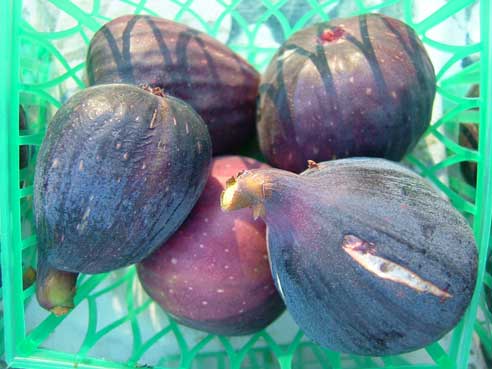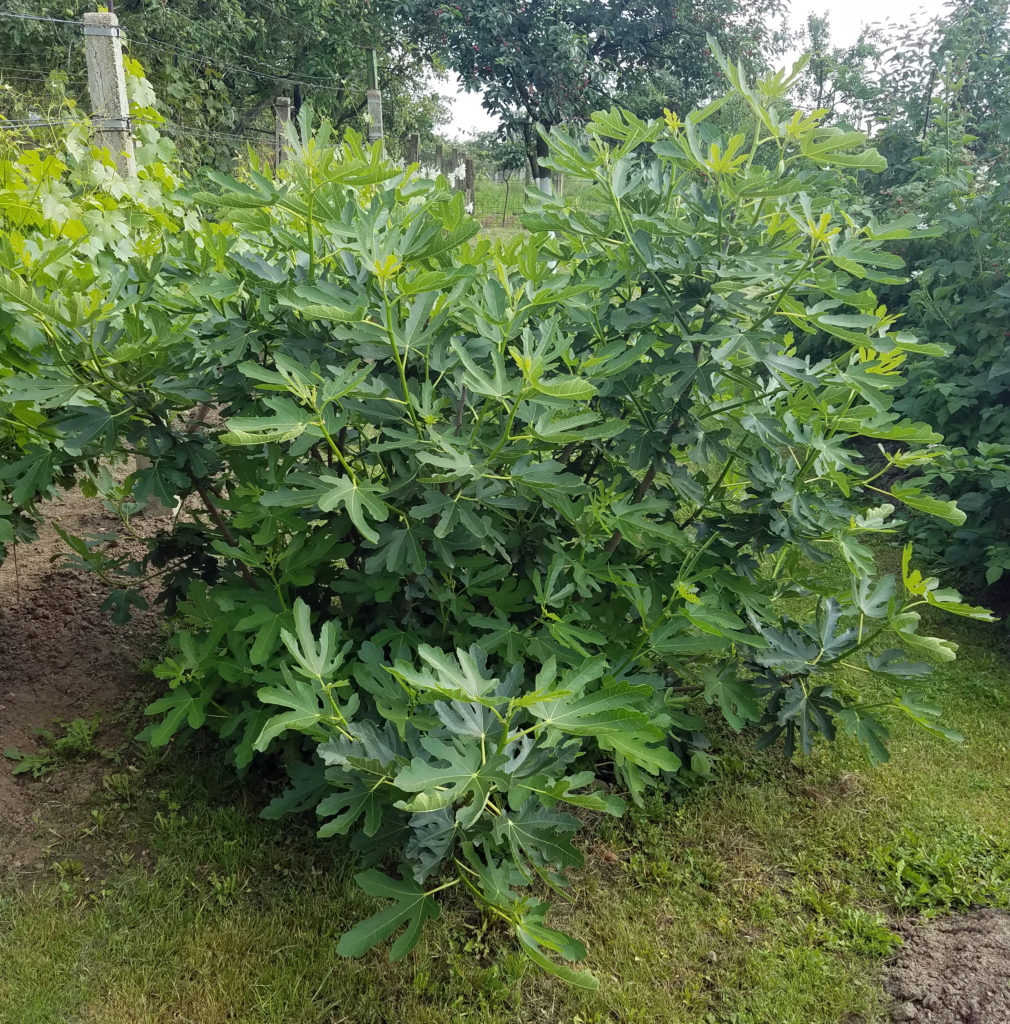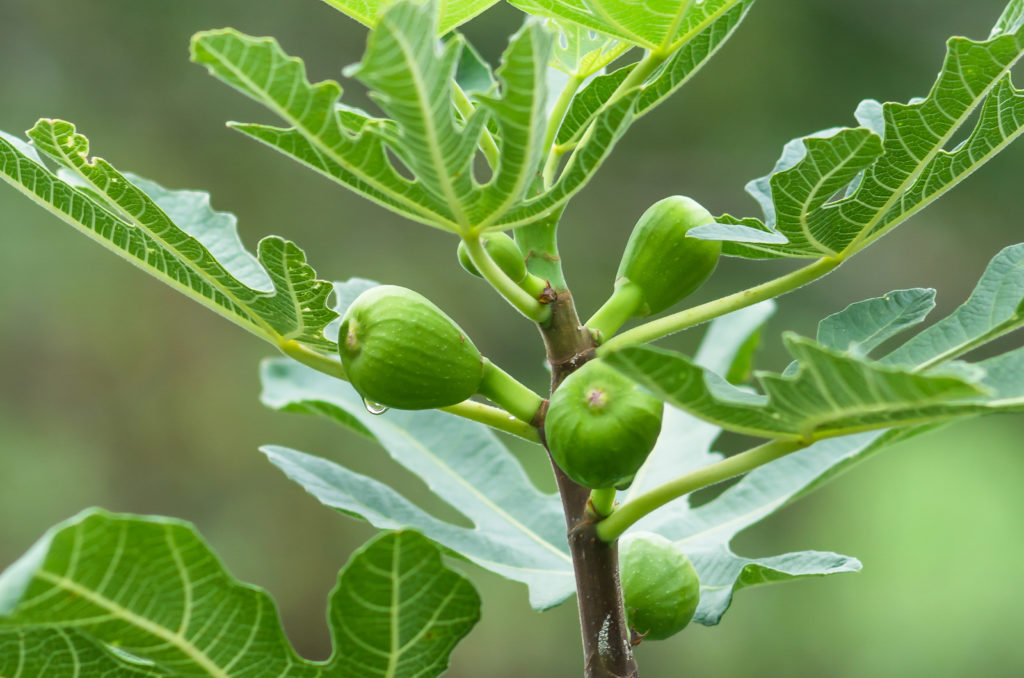
Figs are one of the sweetest fruits.
Figs can be purple, green, yellow, or white-skinned depending on the variety. The flesh can range from gold to deep red. When ripe the moist flesh is intensely sweet and the skin is edible.
Figs are easy to grow and mostly trouble-free. They grow best where winters are mild and summers are long and warm, but figs will grow in cold regions with protection.
Figs are easy to grow in containers. Figs like crowded roots; crowded roots can actually increase fruit production. Even in the coldest winter regions, figs in containers can sit outdoors in summer and be brought indoors in winter.
Related article:
Here is your complete guide to growing figs.
Best climate and site for growing fig trees
- Figs grow unprotected outdoors in Zones 8 to 10 and in protected areas as far north as Zone 6. In colder winter regions, grow figs in a container that can be moved indoors in winter.
- Choose a cultivar appropriate for your climate. Check with the nearby Cooperative Extension Service for a recommendation for the fig varieties commonly grown in your area.
- Plant figs in full sun. In cool summer regions, plant figs near a protected south-facing wall that collects solar heat during the day and radiates it back out at night.
- Choose a site protected from strong winds. Avoid low spots where chilly air or frost can settle. Young trees can be injured by frosts and should be protected.
- Figs can grow in a wide range of garden soils. Well-drained soil rich in loam is optimal.
- Figs grow best where the soil pH is between 5.5 and 8.0. If the soil is too alkaline or salty leaf tips will burn.
- Keep the soil evenly moist for the best fruit set and yield. Mature fig trees can tolerate drought but still need some irrigation.

Spacing fig trees
- A full-size fig can grow to 20 feet tall or more. Space plants 25 feet apart.
- A fig tree can grow up to 1 foot each year but can be pruned smaller.
- Trees growing in containers can be kept 5 to 10 feet tall with annual pruning.
Planting a fig tree
- Plant figs in spring as soon as the soil is workable; plant before hot, dry weather comes or wait and plant later in fall.
- Prepare a planting site in full sun that is sheltered from a prevailing breeze or wind.
- Work well-rotted compost or manure into the soil and add a cupful of all-purpose fertilizer to the bottom of the hole.
- Dig a hole half again as deep and twice as wide as the tree’s roots.
- Put a tree stake (or support wires for a fan) in place before planting. Drive the stake into the ground to the side of the hole to at least 2 feet deep.
- Set the tree in the hole so that the soil mark on the stem from the container is at the surface level of the surrounding soil. (Remove all twine and burlap from balled-and-burlapped trees.) Spread the roots out in all directions.
- Re-fill the hole with half native soil and half aged compost or commercial organic planting mix; firm in the soil so that there are no air pockets among the roots. Water in the soil and create a modest soil basin around the trunk to hold water at watering time.
- Secure the tree to the stake with tree ties.
- After planting, water each tree thoroughly and fertilize it with a high-phosphorus liquid starter fertilizer.
- To restrict the size of a fig tree, plant the tree in a container sunk into the soil; this will deliberately restrict root growth and, in turn, restrict the size of the tree.
Container growing a fig tree
- Figs can be grown in large containers. Figs don’t mind restricted roots; they will thrive and actually yield more fruit when the roots are pot-bound.
- Choose a container at least 18 inches wide and high
- In cool regions, plant in containers that can be moved indoors in winter.
Training a fig tree
- Train a free-standing fig tree to an open center with a balanced framework of lateral branches.
- First-year: Select 3 or 4 well-spaced main laterals and prune each back by half; cut to buds that face outward. Cut off the central leader to just above the topmost lateral.
- Second-year: laterals chosen last year will now have new growth called sub-laterals; choose 3 or 4 of each and cut them back by half; also remove all weak, crowded, crossing; and shoots growing from the main trunk. The limb framework is not established.
- Following years: cut out dead, damaged or diseased wood; thin congested wood to that sunlight and air can get to the center of the tree. Head back the tree to control height.
Fig tree pollination and fruit set
- Most figs are self-fruitful. The flowers are borne inside the fruit. A few figs are not self-fruitful; they are pollinated by a tiny wasp called a fig wasp. The best choice is to select a self-pollinating variety adapted to your climate.
- A fig tree will produce new young fruits twice a year.
- The first fruits evident each year begin to fatten in spring on the end of last year’s growth; they will go on to maturity and ripening and harvest in summer. These fruits actually appeared as embryonic, pea-size fruits at the end of the previous summer and fall.
- The second set of fruits develops at the end of this year’s growth; they begin to appear at the end of summer. If left on the tree they can overwinter (in mild winter regions) and will become the crop for harvest next summer.
- Fig fruits for harvest this year and figs for harvest next year will be on the tree at the same time.
- Most figs are self-fertile; they do not require a second tree for pollination. Self-fertile varieties include ‘Dottato’ (‘Kadota’), ‘Black Mission’, ‘Brown Turkey’, ‘Brunswick’, ‘Celeste’, and ‘Texas Everlasting’.
- A few figs require cross-pollination by the fig wasp (a rare insect). These are known as Smyma figs and include the cultivars ‘Marabout’, ‘Inchàrio’, and ‘Zidi’.
- A few more varieties will produce an early crop each year without pollination and a second crop in fall if a pollinator is present. These are called intermediate or San Pedro figs and include the cultivars ‘Lampeira’, ‘King’, and ‘San Pedro’.

Pruning fig trees for fruit production
- A fig that has been trained to an open center will need light maintenance pruning twice a year.
- Prune in spring: thin out old or damaged wood; thin out excess growth as needed to allow for good light penetration into the center of the plant.
- Prune in summer: pinch out the growing tip of each new shoot as soon as 5 to 6 leaves appear; this will stimulate the formation of new embryo fruits that will develop and ripen next year.
- In cold winter regions, remove any unripe figs larger than a pea in late fall; they will not survive cold weather and will not ripen this year or next.
- New fruitlets start to form almost as soon as the tree emerges from winter dormancy.
Fig Tree care, feeding, and watering
- Feed figs a balanced fertilizer in early spring. A mature fig tree will benefit from 1 to 1 ½ pounds of nitrogen each year. Feed figs a dilute solution of fish emulsion each week during the growing season.
- Keep the soil evenly moist, particularly in spring and summer. A fig tree can go dry, but fruit set and yield will suffer.
- If a fig tree sheds its leaves during the growing season, the cause could be a lack of nitrogen or insufficient water.
- Mulch fig trees in early spring with well-rotted compost or manure; apply about two inches of organic mulch to the drip line. Organic mulch will help conserve soil moisture and feed the tree as well.
- When frost threatens, protect the tree with a plant blanket or burlap if possible.

Harvesting and storing figs
- Figs produce fruit a year after planting.
- In mild winter and very long, warm summer regions, a fig tree may ripen two crops in one season, the first in early summer, the second in late summer or fall. In cooler summer regions, a fig tree will ripen one crop in late summer.
- A ripe fig will be soft with a slightly flexible neck; commonly the neck will bend over under its own weight. Often a bead of nectar will appear at the eye of the fruit and the skin will be split.
- Harvest figs by cutting away the fruit and a section of stem with a pruner.
- If a milky latex sap oozes at the stem end when the fruit is picked, that fruit has not reached full ripeness. Note: be careful not to get the milky sap on your skin or clothes; it can be caustic.
- Figs that are not quite ripe can be ripened at room temperature for a day or two.
- Fig can be eaten fresh, frozen or dried.
- Figs will keep for a few days in the refrigerator.
- Fresh frozen figs retain their natural color, flavor, and texture.
- Cut figs in half and dry them for longer storage. To dry figs, let them dry mostly on the tree and drop naturally to the ground (figs left to mature on the tree have a high sugar content and quality); pick up dropped figs within one or two days to dry them further; set them singly on a tray in a warm, shady spot to finish drying.
Fig tree pests, diseases, and problems
- Birds and wasps eat ripe figs. Place netting over trees to discourage birds; green-fruited varieties are less appealing to birds. Set pheromone traps to catch and kill wasps.
- Mealybugs are white, fluffy-looking insects that feed on the sap in leaves. Spray with insecticidal soap.
- Scale are insects with shell-like coverings that suck sap from leaves and stems. Spray plants with an all-season horticultural oil to smother scale.
- Spider mites feed on sap from leaves causing leaves to become dull and mottled. Spray with water regularly to increase humidity; spray with insecticidal soap or neem.
- Rust is a fungal disease that can leave leaves streaked with rust-colored fungal spores. Spray plants with a fungicide and increase air circulation around trees.
Fall and winter fig tree care
- In Zones 7 and colder, protect figs from freezing temperatures. Wrap them in burlap or plant blankets or bring them indoors in winter. In Zone 8 and warmer, protect fig trees from frost with heavy row covers, frost blankets, or burlap.
- In cold winter regions, remove and discard any green fruit that has not ripened in late fall.
Propagating figs
- Figs do not produce seeds.
- Figs are commonly propagated by cuttings. Root a 6-inch long tip cutting in moist potting mix.
- Figs can be propagated from suckers; cut suckers from roots and replant them.
Fig varieties to grow
- ‘Brown Turkey’: rich flavor, few seeds; mahogany-brown skin tinged purple.
- ‘Conardria’: very sweet; medium size fruit; greenish-yellow to white skin.
- ‘Desert King’: excellent quality; large fruit with dark green skin.
- ‘Genoa’: good flavor; excellent for fresh eating; medium-size fruit.
- ‘Kadota’: rich sweet flavor; medium to large fruit; yellowish-green, tough skin.
- ‘Mission’: excellent flavor; eat fresh, dried, or canned; large fruit with purplish back skin.
- ‘Osborn Prolific’: strong flavor; medium-size fruit; purplish-brown fruit.
- ‘Texas Everbearing’: good quality; medium to large fruit with purplish skin.
- ‘Violetta’: good flavor; red-fleshed fruit; green-purple skin.
- ‘Panache’: sweet-tasting, bright red flesh; striped yellow and green skin.
Also of interest:
Related articles:
Planning the Home Fruit Garden
Garden Planning Books at Amazon:
- Vegetable Garden Almanac & Planner
- Kitchen Garden Grower’s Guide Vegetable Encyclopedia
- Vegetable Garden Grower’s Guide
- Tomato Grower’s Answer Book
More fruit-growing articles:
Learn how to plant, grow, prune, and harvest your favorite fruits. Click below for all you need to know.
- Apple
- Apricot
- Avocado
- Banana
- Blackberry
- Blueberry
- Cantaloupe
- Chayote
- Cherimoya
- Cherry
- Citrus
- Clementine
- Cranberry
- Currants
- Elderberry
- Feijoa
- Fig
- Gooseberry
- Grape
- Grapefruit
- Guava
- Kiwifruit
- Kumquat
- Lemon
- Lime
- Loquat
- Mandarin
- Mango
- Melon
- Mulberry
- Muskmelon
- Nectarine
- Olive
- Orange
- Papaya
- Passion Fruit
- Peach
- Pear
- Persimmon
- Pineapple
- Pineapple Guava
- Plantain
- Plum
- Pomegranate
- Pumpkin
- Quince
- Raspberry
- Strawberry
- Tangelo
- Tangerine
- Tangor
- Watermelon















